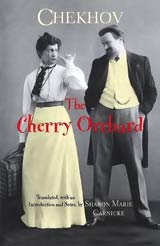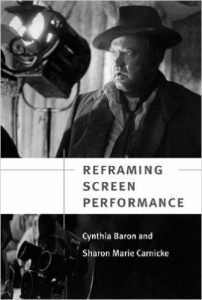Published Works

Active Analysis is an innovative rehearsal technique that fosters in actors the necessary flexibility of mind, body and spirit to cope with current changes in plays and performance styles. Part mystery and part drama, Dynamic Acting Through Active Analysis uncovers the technique’s hidden history and guides actors to its effective practice
“In our current moment as we transition to more collaborative environments, Active Analysis will prove to be a boon for rising theatre artists.” Anne Bogart, Founder and Co-Artistic Director of SITI Company
“Carnicke presents Active Analysis as a usable methodology for any actor or director. A true gift!” Milton Justice, Author and Podcaster of I Don’t Need an Acting Class
“Carnicke presents a fresh approach to acting and directing in any style of theatre or film.” Michael King, Northern Kentucky University
“With intelligence, wit, compassion and respect for the traditions of theatre, Carnicke guides us to the continuing vitality of Active Analysis in our ever changing world. Her book is a testament to the resilience of the human spirit.” Mary Joan Negro, Actor, Director, Tony Award Nominee, and Acting Teacher

Stanislavsky in Focus: An Acting Master for the Twenty-First Century
Second Edition
Confused about the many techniques associated with the great Russian acting teacher Stanislavsky? This book sets the story straight by going back to his Russian-language texts, letters, and notebooks. Carnicke sets forth what Stanislavsky actually taught during his life-time and what he believed about the nature of acting. She separates myth from reality, and also examines key differences between the Russian System of Actor Training and the American Method. The glossary of Stanislavsky’s terminology, with its clear definitions and its historical acting exercises, is alone worth the price of the book.
“Outstanding … There are innumerable books about Stanislavsky. Stanislavsky in Focus is the only book worth taking seriously.”
David Chambers, Yale School of Drama, New Haven

Chekhov: 4 Plays and 3 Jokes
Translated and Introduced by Sharon Marie Carnicke
Want a fresh look at Chekhov’s plays? This volume offers lively, actor-friendly, and accurate translations of Chekhov’s four major plays, as well as three of his most hilarious one-acts. Included is Carnicke’s award-winning Seagull, which “highlights Chekhov’s bitter humor [and makes clear] why Chekhov called it a comedy in four acts” (Sandra Knife, The Evansville Press). The down-to-earth introduction and cultural notes will benefit actors, directors, students, and general audiences alike.
“Beautifully captures the world of Chekhov that continually teeters between human folly and dignified but poignant heartbreak. I cannot imagine a better compilation to introduce actors to Chekhov.” Mary Joan Negro, Actor/Director and Founding Member of The Acting Company
“These new translations read smoothly and display fidelity to the original. Carnicke has aimed to find a middle path between versions that are too colloquial and versions that sound stilted or too formal to the American ear and has succeeded.” Jullian W. Connolly, University of Virginia

Chekhov: The Cherry Orchard
Drawn from Chekhov: 4 Plays and 3 Jokes(Hackett), this edition of The Cherry Orchard features Carnicke’s groundbreaking translation of a play that has been called “Chekhov’s ultimate theatrical coup d’état.” The revised introduction includes new material on Chekhov’s last masterpiece. Carnicke’s translation is “direct, easily accessible to young American students and mercifully free of all that blather that mucks up so much of the other versions that I know.” James Parker, Late Professor of Theatre, Virginia Commonwealth University.

Chekhov: Three Sisters
First published in Chekhov: Four Plays and Three Jokes, Carnicke’s eye-opening translation “shows her background in the Slavic field to good advantage. Chekhov doesn’t emerge as ‘the voice of twilight Russia,’ or anything mawkish at all, as he sometimes does, but as a sharp-eyed watcher of some very silly people. Carnicke understands Chekhov and understands Russia. Robert L. Belknap, the late Professor of Slavic Languages, Columbia University.

Checking out Chekhov: A Guide to the Plays for Actors, Directors, and Readers
Sharon Carnicke brings three decades of theatrical and scholarly experience with Chekhov’s plays to this vivid portrait of Anton Chekhov—a writer whose elusive personality and richly detailed plays have left an indelible imprint on the world’s theatre. Every page reveals the joys and difficulties of his short life, comic sensibility, deep compassion, and often puzzling use of dramatic style and genre. Carnicke demystifies Chekhov’s plays—forged from his literary innovations, avid theatergoing, love of vaudeville, and loathing of melodrama. She interweaves biographical and cultural information with insightful case studies and close analysis to leave her reader with a full and fresh perspective on an artist, who is as foundational to theatrical traditions as are Shakespeare and Stanislavsky.
“Carnicke’s book brilliantly captures the essence of Chekhov. I can’t think of a better introduction to the work of this most elusive of modern writers.”
Peter McAllister, The Royal Central School of Speech and Drama, London

Reframing Screen Performance
Co-authored with Cynthia Baron
In this volume, Carnicke and Baron challenge the long-held belief that cinematic performances are created in the editing room. They demonstrate how various vocabularies, primarily drawn from actor training systems, can be productively used to analyze how actors contribute to the meanings and impacts of films. If you believe that actors are vital to cinema and that screen acting deserves serious study, then this book is for you.
“A significant contribution to the literature on screen performance studies [that] brings the study of film acting up to date.” Frank P. Tomasulo, Florida State University.
“Compelling case studies reveal how an actor’s film performance contributes to cinematic aesthetics and audience perception. … This unique exploration [is] required reading.” J. Artman, Choice.
“A powerfully argued book.” Steve Neale, Screen.

Actor Training
Edited by Alison Hodge
Second edition
“Carnicke’s incisive examination of Stanislavsky and his work in the opening chapter entitled ‘Stanislavsky’s System: Pathways for the Actor‘ launches [this] anthology,” writes Cindy Rosenthal in Theatre Journal.
In the chapter on “The Knebel Technique: Active Analysis in Practice,” Carnicke has authored the first English language introduction to the work of Maria Knebel, Stanislavsky’s last assistant and Russia’s most influential directing teacher. As director Anatoly Efros put it, “I actually understood [Stanislavsky] only when I came into contact with Maria Knebel.”

The Routledge Companion to Stanislavsky
Edited by Andrew White, consulting editor Sharon Marie Carnicke
In “The Effects of Russian and Soviet Censorship on the Practice of Stanislavsky’s System,” Carnicke exposes how censorship constrained all of Stanislavsky’s theatrical work.
In their co-authored chapter, “A Singer Prepares: Stanislavsky and Opera,” Carnicke and opera scholar David Rosen examine vocal training for both singers and actors.
“White and Carnicke bring together 22 thorough essays of about 20 pages, each with a bibliography. Combining scholarly research and professional theater experience, this book reveals an intriguing account of, and debate about, the past and present and also projects into the future. Summing Up: Recommended.” – J Toma, San Francisco State University in CHOICE

The Great European Stage Directors Volume 1: Antoine, Stanislavski, Saint-Denis
Edited by Peta Tait
Carnicke’s chapter, “Rethinking ‘Stanislavskian’ Directing,” challenges Stanislavsky’s reputation for realism by tracing his evolution as a director through three radically different productions: his realist staging of Chekhov’s Seagull; his experiments with symbolism for Hamsun’s The Game of Life; and his minimalist direction of Tchaikovsky’s opera, Eugene Onegin.

Chekhov’s Letters: New Approaches and Readings
Edited by Carol Apollonio and Radislav Lapushin
In her personal essay, “Forgive, Forget, and Write: Anton Chekhov’s Advice to a Fellow Writer,” Carnicke shares with her readers Chekhov’s advice on writing that she found most helpful in her own career.

Chekhov the Immigrant: Translating A Cultural Icon
Edited by Michael C. Finke and Julie de Sherbinin
In her essay, “Translating Chekhov’s Plays without Russian, or, The Nasty Habit of Adaptation, ”Carnicke exposes how Chekhov’s content and style is often distorted by translators and adapters who cannot read Russian.

Chekhov Then and Now: The Reception of Chekhov in World Culture
Edited by J. Douglas Clayton
In her chapter, “Stanislavsky’s Production of The Cherry Orchard in the US,” Carnicke takes “a sobering look at how popular taste shapes art.” (North American Chekhov Studies)

The Politics of American Actor Training
Edited by Liisa Tyler-Renaud and Ellen Margolin
In “Stanislavsky and Politics: Active Analysis and the American Legacy of Soviet Oppression” Carnicke builds upon her excellent work in the second edition of Stanislavsky in Focus.” Steven Harrick, Theatre Topics

Theorizing Film Acting
Edited by Aaron Taylor
If you thought that John Wayne was unaware of acting techniques, Carnicke’s essay, “The Screen Actor’s ‘First Self’ and ‘Second Self’: John Wayne and Coquelin’s Acting Theory,” about Wayne’s role in The Searchers will surprise you.

Mapping Landscapes for Performance as Research: Scholarly Acts and Creative Cartographies
Edited by Shannon Rose Riley and Lynette Hunter
Carnicke contributes to this first anthology in the United States about practice-based methodologies for theatre research by exploring how Delsarte can teach acting to computer generated Intelligent Virtual Agents in her chapter, “Collisions in Time: Twenty-First Century Actors Explore Delsarte on the Holodeck.”

“The Material Poetry of Acting: Objects of Attention, Performance Style, and Gender in The Shining and Eyes Wide Shut,” Journal of Film and Video, Special Issue on Acting: 58: 2 and 3 (Summer/Fall 2006), 21-30.
In this stunning article, Carnicke explores how vocabulary drawn from actor training can be used by cinema scholars to analyze filmed performances.

More Than A Method
Edited by Cynthia Baron, Diane Carson, and Frank Tomasulo
“In ‘Collaborations between Screen Actors and Directors’ Carnicke sets the tone for the whole book by adding much needed complexity to the subject of screen performance.” Film Quarterly.

“Contemporary Hollywood Stardom
Edited by Martin Barker and Thomas Austin
In “From Acting Guru to Movie Star: Lee Strasberg as Actor” Carnicke explores Strasberg’s late-blooming career as an actor, that began when he was cast in The Godfather, Part II.

Acting and Performance in Moving Image Culture
Edited by J. Sternagel, D. Levitt, and D. Mersch
Learn about the making of Gollum in Carnicke’s chapter on “Emotional Expressivity in Motion Picture Capture Technology.”



